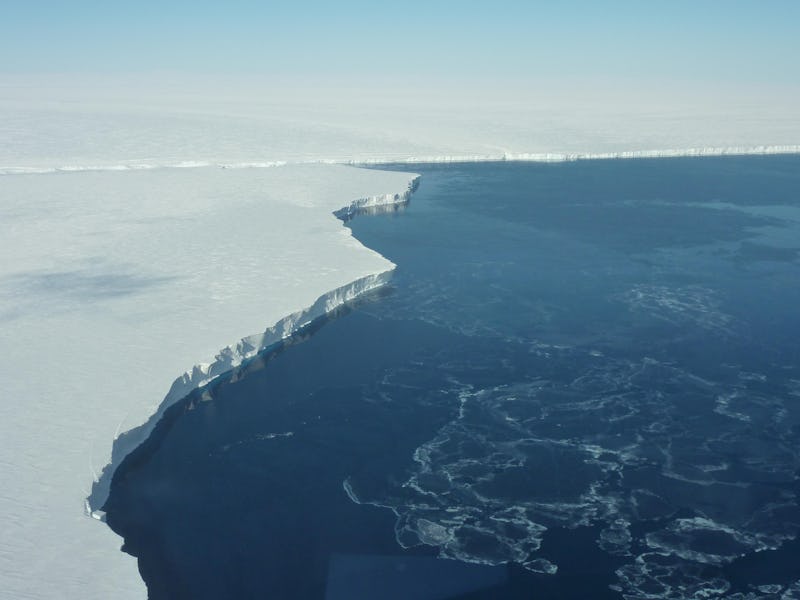How a Giant Iceberg Breaking Off the Larsen C Ice Shelf Affects the Planet
Maps of Antartica will need to be redrawn.

Scientists confirmed Wednesday morning an iceberg as big as Delaware has calved from the Larsen C ice shelf in Antarctica. This slab of ice is about 100 miles long, 30 miles wide, and 600 feet thick. It weighs a trillion tons, which means it would fill the volume of Lake Erie with ice twice over.
This calving event is spectacular in its magnitude, as it’s the third largest iceberg ever documented, and the landscape of Antartica has changed to the point where maps will have to be redrawn. While that may seem dramatic, this isn’t a catastrophic event. It is perfectly normal and expected for ice shelves to calve icebergs. They are dynamic systems, and that is part of it.
But what exactly is an ice shelf? Basically, an ice shelf is a flat expanse of ice floating out over the ocean that is still attached to land ice. They are fed by glaciers flowing on the continent behind.
Snow falls on Antarctica’s glaciers, and rather than melting each summer, it simply compresses and compacts until it becomes part of the glacier ice. This new ice above is heavy, and with the forces of gravity, it pushed down on the glacier below.
Although they are made of solid ice, glaciers flow very slowly downwards. Imagine pouring thick honey down the side of a mountain, moving a few feet per day. With calving, it’s much more violent than the flow of honey, as solid ice crunches, creaks, and cracks under the enormous pressure.
Under certain conditions, when this flowing ice meets the ocean, it continues to flow out to sea while remaining attached to the glacier behind. This creates an ice shelf, like a pool of honey accumulating on a table.
Ice shelves grow from the continued flow of the glacier behind, but they also shrink, either by melting (as it comes into contact with warmer air above and water below) or by calving off chunks of ice, becoming icebergs.
Rifts, or cracks, in ice shelves form from a combination of meltwater and physical stress. Scientists at Project MIDAS have tracked the rift that formed this iceberg since 2014 as it progressed from one end of the ice shelf to the other, taking a large bite out of it.
Ice shelves are an important part of the Antarctic landscape. Larsen C is the largest shelf on the Antarctic Peninsula and the fifth largest on the continent. It was the fourth largest before the iceberg broke off — the berg accounted for more than 10 percent of its area.
And ice shelves are in danger. Larsen B and Larsen A, two smaller neighbors of Larsen C, both collapsed dramatically in recent decades, changing the Antarctic landscape permanently.
This has important implications for global sea level rise since ice shelves work like a dam to hold back the flow of glaciers behind. When ice moves from land to sea, this increases the volume of the ocean. Without ice shelves, sea levels would rise at a much more dramatic rate, threatening island nations and coastal cities around the world.
But the fate of Larsen C is uncertain. It could be that the shelf continues to do as it has done for many thousands of years, growing from behind and calving from the front in a state of equilibrium.
Some scientists, though, believe that this calving event could be the beginning of the end of Larsen C, exposing weaknesses in its structure caused by a warming environment that will lead to its collapse over coming years or decades.
The calving event is dramatic, but the most important and interesting part is what happens next.